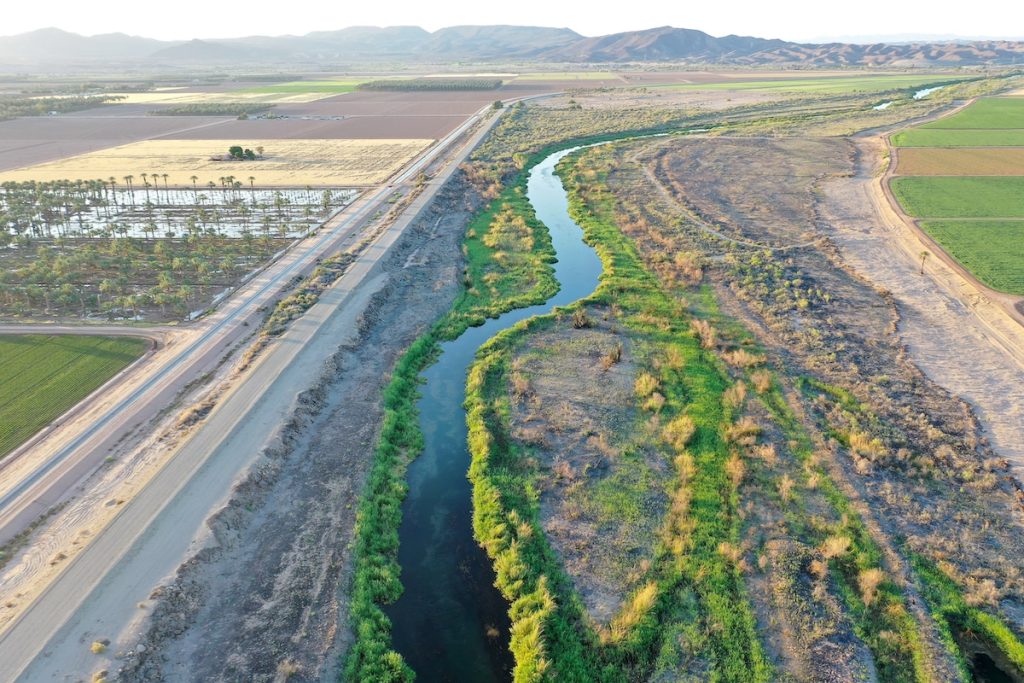Rivers Can Take Years to Recover From Drought, Research Finds
4 min read
The long-depleted Colorado River flowing along the border between California (L) and Arizona near Yuma, Arizona on May 25, 2023. Mario Tama / Getty Images
Founded in 2005 as an Ohio-based environmental newspaper, EcoWatch is a digital platform dedicated to publishing quality, science-based content on environmental issues, causes, and solutions.
Drought is usually associated with lack of rainfall, but there are other factors, like snowmelt and groundwater, that can affect the water levels of streams and rivers.
In a new study, researchers from University of California, Riverside (UCR), found that drought impact can persist for as long as three-and-a-half years in rivers and streams despite precipitation from a series of storms, a press release from UCR said.
The total water level of streams is measured by two factors: total water level, affected by rainfall and snowmelt, and baseflow, the share fed by groundwater.
“People often just use rain as an indicator of drought because it’s easier to measure. But there are other kinds of drought that each have their own impacts,” said Hoori Ajami, the study’s corresponding author and associate professor of groundwater hydrology at UCR. “We needed a new way to see how long it takes for one form of drought to become another form.”
Baseflow droughts are studied by fewer researchers, and there had not previously been an accurate measurement technique for them. Since lack of baseflow significantly impacts ecosystem services, as well as water management, the researchers chose to turn their focus on this important aspect of hydrology.
The study, “Comprehensive assessment of baseflow responses to long-term meteorological droughts across the United States,” was published in the Journal of Hydrology.
The category of drought that affects rivers and streams is called hydrological drought, to which baseflow belongs. Baseflow impacts water availability for drinking, bathing and irrigation. It affects plants, wildlife and the overall health of ecosystems. Infrastructure stability could also be impacted by severe hydrological drought.
In order to develop a method for defining the start and end points of hydrological droughts in specific locations, the researchers looked at three decades’ worth of data from 350-plus locations around the U.S.
The research team only looked at baseflow on rivers and streams that did not have any dams or reservoirs and had not been impacted by human activity.
The results showed that a hydrological drought’s beginning and end is dependent on a variety of factors, including a location’s geography and typical climate.
A wide array of lag times were found between the end of a drought due to lack of rainfall and the conclusion of a baseflow drought. For instance, streams in parts of Kansas took 41 months to recover, but those in Pasadena’s Arroyo Seco area took nearly a year.
“When we are looking at water management strategies, it is clear we cannot implement a one-size-fits-all solution everywhere, for every stream. Our approaches need to be site specific,” said lead author of the study Sanghyun Lee, who is now a postdoctoral fellow with the USDA’s Agricultural Research Service in Oklahoma, in the press release. “When I first came to California in 2016, people asked me, ‘Is the drought over?’ They wanted to know if our watersheds had recovered. This new study shows it may take another few years until they get back to normal.”
The team’s results were consistent with earlier studies finding that water recovery in underground aquifers also experiences a delay in responding to lack of rainfall. Aquifers are an important water source for agriculture, as well as rivers’ baseflow.
Too much pumping of groundwater during drought could lead to sinkholes, which can cause shifts or even the collapse of buildings and other types of infrastructure.
“One key message we want to send is that people must be careful about managing the water they have,” Lee said in the press release. “Because of rising temperatures, baseflow drought is getting longer and more severe in many parts of the country. And because watershed boundaries often cross state or international lines, preserving precious water resources will require more cooperation.”
Subscribe to get exclusive updates in our daily newsletter!
By signing up, you agree to the Terms of Use and Privacy Policy & to receive electronic communications from EcoWatch Media Group, which may include marketing promotions, advertisements and sponsored content.





